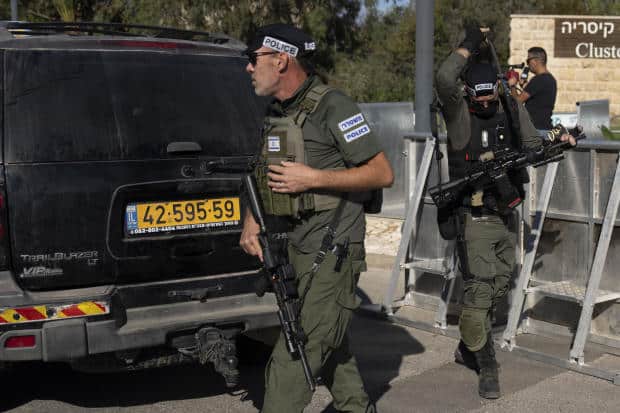CAESAREA, ISRAEL – In a dramatic turn of events, Israeli Prime Minister Benjamin Netanyahu’s private residence in the coastal town of Caesarea was reportedly targeted by a drone on Saturday, as hostilities between Israel and Lebanon-based Hezbollah escalated. The drone strike is the latest flashpoint in a growing conflict marked by cross-border attacks and rising casualties.
According to the Israeli government, a drone was launched toward Netanyahu’s home, though the prime minister and his wife were not present at the time, and no injuries were reported. Details remain scarce, and whether the drone reached its intended target is unclear. Israeli military officials have not confirmed whether the drone was intercepted, nor have they provided information on possible damage.
Netanyahu Undeterred Despite the Attack
Shortly after the attempted strike, Netanyahu issued a defiant response. “Anyone who tries to harm Israel’s citizens will pay a heavy price,” he said, describing the incident as a “grave mistake” orchestrated by Hezbollah, which he labeled as an “Iranian proxy.”
The drone attack marks the second attempt on Netanyahu in recent months. In September, Yemen’s Houthi rebels launched a ballistic missile at Ben Gurion Airport during Netanyahu’s landing, which was intercepted. These threats underscore the heightened risks surrounding Israel’s top leadership as the regional conflict intensifies.
Israel Responds to Hezbollah’s Escalation
On the ground, fighting between Israel and Hezbollah has escalated, with Israel launching at least 10 airstrikes on Beirut’s southern suburbs. Known as Dahiyeh, the area serves as Hezbollah’s headquarters. Lebanese authorities reported multiple strikes, including one targeting Hezbollah’s deputy commander, Nasser Rashid, in the town of Bint Jbeil.
Hezbollah, backed by Iran, recently announced a “new phase” in its campaign against Israel, claiming responsibility for launching over 200 projectiles into northern Israel on Saturday. The barrage included rockets and drones, resulting in the death of a 50-year-old man and injuries to four others. The Iranian-backed group has vowed to increase its use of guided missiles and drones in retaliation for the killing of its longtime leader, Hassan Nasrallah, in a September airstrike.
The drone strike on Netanyahu’s residence comes as Israel gears up for a potential retaliation against Iran for a massive ballistic missile attack on October 1. Defense Minister Yoav Gallant promised a “deadly, precise, and surprising” response to the Iranian strike.
Gaza Conflict Adds Pressure
Simultaneously, fighting continues in Gaza between Israel and Hamas. Tensions have been high following the killing of Hamas leader Yahya Sinwar earlier this week, whom Israel accused of masterminding the October 7, 2023, attack that killed over 1,200 Israelis and saw more than 250 people taken hostage.
Hamas, while acknowledging Sinwar’s death, maintains its demand for a cease-fire and the withdrawal of Israeli troops from Gaza as conditions for releasing the hostages. Israeli Prime Minister Netanyahu, however, has rejected these terms, stating that the military offensive in Gaza will continue until all hostages are freed and Hamas is politically dismantled.
The ongoing offensive in Gaza has had devastating consequences. Palestinian health officials reported at least 42,000 casualties, with more than half being women and children. Israeli strikes on hospitals, residential buildings, and civilian infrastructure have compounded the humanitarian crisis, leading to widespread displacement and shortages of essential resources such as food, water, and medicine.
International Reactions and Diplomatic Moves
The attempted drone attack has also drawn international concern. U.S. Secretary of Defense Lloyd Austin spoke with Israel’s Defense Minister Gallant shortly after the incident, expressing relief that Netanyahu was unharmed. The two officials discussed the deployment of a Terminal High-Altitude Area Defense (THAAD) system in Israel aimed at countering potential missile attacks from Hezbollah and Iran.
The U.N. and other international bodies have called for de-escalation on both fronts. In a statement, U.N. Secretary-General António Guterres emphasized the urgent need for a cease-fire, expressing hope that Sinwar’s death could pave the way for negotiations. Meanwhile, residents of Gaza and Lebanon, exhausted by continuous airstrikes, also voiced hopes for an end to hostilities.
Impact on Civilians in Lebanon and Gaza
While the conflict between Israel and its adversaries intensifies, civilians in Lebanon and Gaza bear the brunt of the violence. In Lebanon, airstrikes have targeted not only Hezbollah positions but also residential areas, leading to significant casualties. On Saturday alone, Israeli strikes reportedly killed seven people in a vehicle near Beirut and five others, including a local mayor, in Baaloul village.
In Gaza, the humanitarian toll is even more severe. Strikes have hit residential buildings, hospitals, and vital infrastructure, with reports of at least 73 people killed in a single attack in Beit Lahiya. The U.N. has called the situation in Gaza “dire,” with 90% of the population displaced and struggling to find basic necessities. Ongoing strikes in the densely populated region have led to mounting casualties and injuries, with local officials describing the destruction as “unprecedented.”
Looking Ahead: Cease-Fire or Continued Conflict?
As tensions rise and casualties mount, diplomatic efforts are underway to seek a potential cease-fire. Israel’s allies, particularly the U.S. and European nations, are urging restraint while pressing for negotiations to resolve the hostage crisis and ease the humanitarian crisis in Gaza. However, with Hezbollah’s vow to escalate and Israel’s determination to press forward, the region seems poised for more conflict in the days ahead.

